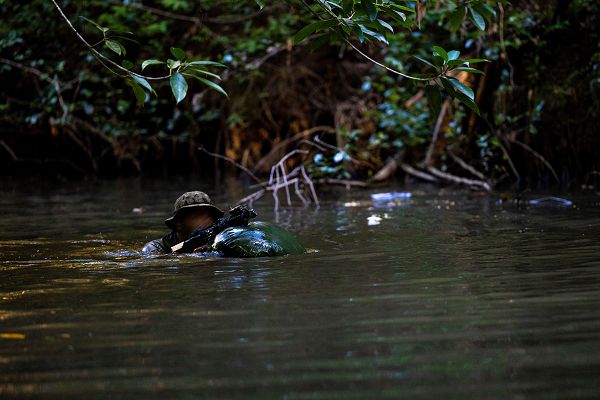
Camp Lejeune, North Carolina. (October 3, 2023): They were sometimes resented by their fellow Marines due to their status as an “elite unit” within an elite force. The Marine Raiders were organized in 1943 as the Corps’ first special operations unit and their valor was never questioned. In this photo by Corporal Henry Rodriquez, a Marine Raider with Marine Forces Special Operations Command traverses a river during a jungle mobility course on how to maneuver in a tropical environment, conceal their position, and track enemy movements. These men belong to the today’s Marine Special Operations Force that is known once again as the Marine Raider Regiment in an homage to their World War II brothers.
With America’s entry into World War II, President Franklin D. Roosevelt became interested in creating an American counterpart to the British Commandos and Chinese guerrillas operating in northern China. The Marines established two Raider units, the 1st Battalion led by Lt. Col. (later, Major General) Merritt A. "Red Mike" Edson which became one of the first United States special operations forces to see combat during World War II.
Colonel Edson’s Marine Raiders landed at Guadalcanal to defend the recently captured Henderson Field in the famous "Battle of Edson's Ridge". The 1st Raiders scored a major defensive victory over Imperial Japanese Army forces by repulsing attacks by the fanatical Japanese 35th Infantry Brigade, a force 6,000 soldiers who would rather die than surrender. Japanese Major General Kiyotake Kawaguchi was given the unpleasant task of recapturing the airfield from the Marines and driving the Allied forces from the island. Although the Marine defenses were almost overrun, Kawaguchi's attack was ultimately defeated with heavy Japanese losses. Colonel Edson was awarded the Medal of Honor for his actions in the battle.
In thirty-six days of fighting, nearly 7,000 U.S. Marines were killed and another 20,000 were wounded. Marines captured only 216 Japanese soldiers; the rest were killed in action. The changing nature of the war in the Pacific meant that there would be many large-scale amphibious assaults to come against well-defended islands which negated the need for the Marine Raiders. They were disbanded after only two years.


